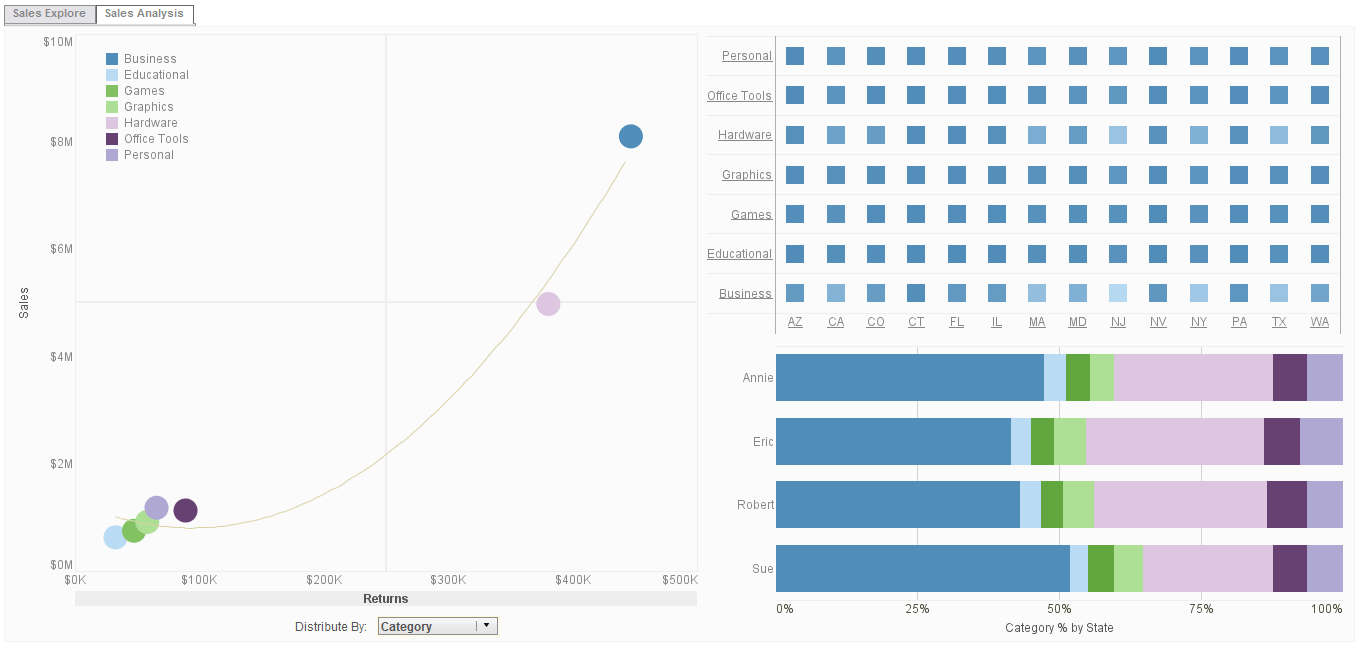Analytic Software That Is Easy to Deploy and Use
Since 1996 InetSoft has been offering business intelligence applications that are flexible and powerful, serving over 5,000 enterprises and solution providers worldwide. StyleBI™ is InetSoft's powerful, yet intuitive analytic software application that leverages a powerful patent-pending Data Block™ foundation for real-time analysis through interactive dashboards, enterprise reporting, scorecards, and exception alerts.
InetSoft's analytic software is:
robust enough to:
- captivate the attention of business users
- maintain high performance under heavy usage
- meet organizational needs of all sizes
and is easy enough to be:
- deployed in a matter of weeks, not months.
- learned and used with minimal training.
and flexible enough to:
- adjust to changing data structures and business needs.
- facilitate data exploration through visualization.
- capable of maximum self service.
| #1 Ranking: Read how InetSoft was rated #1 for user adoption in G2's user survey-based index | Read More |
How a Specialty Plastics Manufacturer Uses InetSoft's Analytics Microservice App, StyleBI
At the edge of a small Midwestern town nestled between sprawling soybean fields and aging rail lines, a factory hummed to life each morning before the sun rose. Plastiform Solutions, a specialty plastics manufacturer, had been a staple of the community for decades. Their products—high-performance plastics for aerospace, automotive, and biomedical industries—were renowned for their quality and customizability.
But despite the gleaming production lines and a proud legacy of innovation in materials science, something wasn't quite right beneath the surface. In recent years, the company had begun to feel the strain of a changing market. Competition had intensified, raw material costs were volatile, and customers were demanding more agile and transparent supply chains. The leadership team, helmed by COO Emily Rhodes, knew they needed a better way to harness their data.
"The data was everywhere," Emily recalled. "We had ERP systems, production control logs, CRM data, vendor spreadsheets, quality reports. But it was siloed, inconsistent, and frankly, not helping us make timely decisions." The company had invested in business intelligence (BI) tools before, but most were heavyweight platforms that required a full data warehouse, extensive training, and months-long implementation cycles. They needed something leaner—more adaptive. That's when their head of IT, Marcus Zhang, discovered InetSoft's StyleBI, an analytics microservice app built with composability and flexibility in mind.
Breaking Down the Silos
What attracted Marcus and his team to StyleBI wasn't just its lightweight deployment model—it was its data mashup engine. Unlike traditional BI tools that required rigid schemas and pre-defined ETL pipelines, StyleBI offered a data workspace that allowed real-time blending of heterogeneous data sources.
Within weeks, they had connected StyleBI to:
-
Their ERP system (Oracle NetSuite),
-
MES (Manufacturing Execution System),
-
Lab testing databases,
-
Inventory spreadsheets housed in SharePoint,
-
And even supplier data pulled from APIs.
"The mashup functionality was a game-changer," Marcus explained. "We could finally combine production cycle data with material lot histories and quality metrics on the fly—no more back-and-forth with BI consultants or writing SQL every time we needed a new dashboard."
From Gut Feelings to Data Confidence
One of the first use cases Emily pushed for was improving yield rates on their thermoforming line—a notoriously fickle process involving heat, vacuum pressure, and proprietary polymers. Historically, line managers relied on experience and intuition to adjust settings and troubleshoot anomalies.
With StyleBI, they built a visual dashboard that combined machine sensor data, environmental readings, batch parameters, and post-production quality assessments. The dashboard surfaced trends no one had noticed before: certain material lots performed worse when humidity spiked, and line speed fluctuations correlated with increased scrap rates.
"Suddenly, we weren't just reacting to problems—we were predicting them," said Ben Alvarado, a senior process engineer. "We created alerts and anomaly detectors that warned us when we were veering out of our optimal parameters. Scrap dropped by 15% in the first quarter alone."
Democratizing Insight
One of StyleBI's most unexpected benefits was how it empowered users beyond IT and engineering. The microservice architecture meant different teams could create their own dashboards and reports within their workflows without waiting on the central data team.Sales reps built customer-specific dashboards showing real-time inventory and estimated ship dates. The quality assurance team monitored test results across facilities. Finance teams integrated revenue forecasting with production capacity models.
"It wasn't just a tool—it became part of how we thought," said Emily. "When you make data visible and intuitive, people start asking better questions. It shifts the culture." And because StyleBI supported embedding, Plastiform added lightweight visualizations into internal web apps and even customer portals—enhancing both employee experience and client satisfaction.
Scalable, Without the Overhead
Plastiform wasn't a giant multinational corporation. Their IT team was lean, and every new platform had to justify itself both in cost and time-to-value. StyleBI's microservice design meant it could scale without adding significant operational overhead.
Instead of monolithic servers or bloated installations, StyleBI ran in containers orchestrated through their existing Kubernetes environment. Marcus's team could spin up new analytics environments for different departments or regions in minutes, not weeks.
"We didn't need to rip and replace our systems. StyleBI just sat on top of them, pulling the insights together," Marcus said. "That's what modern software should do—amplify what you already have."
Strategic Impact
Six months after rolling out StyleBI, Plastiform Solutions had more than just cleaner dashboards—they had a new strategic lens. They discovered that a niche medical plastics line, long assumed to be marginal, was consistently outperforming others when viewed through profitability per production hour. They doubled down on marketing and secured new contracts in that vertical.
They also revamped their vendor management. By tracking supplier lot performance against product yield and warranty claims, they uncovered two vendors whose materials consistently underperformed. Procurement renegotiated contracts, leading to both cost savings and performance improvements. Emily summarized it best: "This wasn't just about better reports—it was about seeing our business clearly for the first time. And once you can see, you can steer."
